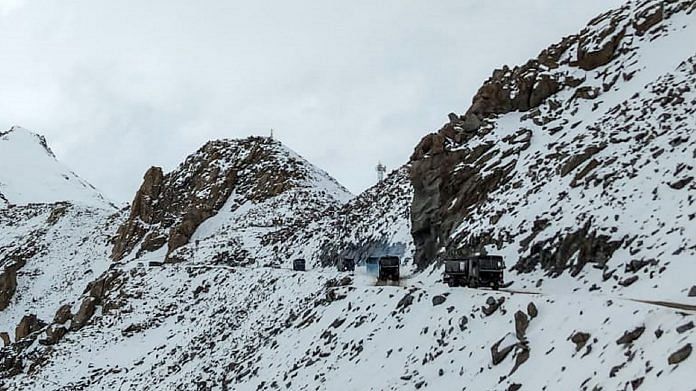New Delhi: In a marathon 16-and-half hours of Corps Commander-level talks that began Sunday, India and China have managed to break the “stalemate”, but a breakthrough in carrying out disengagement is yet to be achieved, ThePrint has learnt.
“Several issues were covered during the talks,” a source from the defence and security establishment told ThePrint. Asked if this meant that India and China have come to an understanding for disengagement, the source said, “not yet”.
Sources further explained that the talks took off from the stalemate that had crept in between the two sides and “substantial” progress has been achieved.
Held at the Moldo meeting point of the Chinese side, the talks began around 1030 hours on Sunday and lasted till about 0230 hours Monday morning, sources added. The meeting was initially scheduled to start about 0900 hours, but was delayed due to bad weather.
Also read: New book traces why India-China ties have been ‘confrontational’ since 15th century
India says disengagement a must, onus on China
The 9th round of the Corps Commander-level talks came after almost three months, the last being held on 6 November. Meanwhile, thousands of soldiers from both India and China continue to be deployed in forward locations in Eastern Ladakh where temperatures have dropped to -30 degree Celsius.
In some locations, like in the Kailash Range on the southern banks of Pangong Lake, troops are literally in an eyeball-to-eyeball situation, with a distance of just a few feet between them. The same also holds true for the tanks being deployed by both sides on heights that are over 16,000 ft.
A joint statement issued by India and China Monday evening said the two sides had a candid and in-depth exchange of views on disengagement along the LAC in the western sector of India-China border areas, and both sides agreed that this round of meeting was positive, practical and constructive, which further enhanced mutual trust and understanding.
“They also agreed to follow the important consensus of their state leaders, maintain the good momentum of dialogue and negotiation, and hold the 10th round of the Corps Commander Level Meeting at an early date to jointly advance de-escalation,” the statement said.
It added that the two sides agreed to continue their effective efforts in ensuring the restraint of the frontline troops, stabilise and control the situation along the LAC in the western sector of the India-China border, and jointly maintain peace and tranquility.
Sources said that during the talks, the Indian side — led by 14 Corps Commander Lt Gen P.G.K Menon and included Naveen Srivastava, joint secretary (East Asia) from the external affairs ministry — made it clear that for tensions to come down, disengagement is a must.
They explained to the Chinese side, which was led by South Xinjiang military district chief Major General Liu Lin, that its People’s Liberation Army (PLA) first transgressed, and hence, the onus is on them to pull back.
While China had the advantage of moving in first, specialised elements from Indian Army had outflanked the PLA and captured dominating heights on the Kailash Range in August.
This gave India a dominating position over the Moldo garrison and the Spanggur Gap which could have been used by the Chinese to launch any attack in the Chushul sector in the Ladakh region.
This resulted in neither side having any overt disadvantage or any overt advantage, with Chinese dominating in certain features and India in others.
Also read: India, China must redouble efforts to ‘meet each other halfway’, envoy Sun Weidong says
India, China continue border reinforcements
The talks also come at time both sides are reinforcing their defensive positions along the Line of Actual Control (LAC) with construction of permanent bunkers.
China, on the one hand, has continued with its construction activities along the LAC such as the creation of new surface-to-air missile sites, broadening of airstrips in Tibet region, and construction of heliports and new roads.
India, on the other hand, has continued with its border infrastructure development despite the Chinese aggression since early May 2020. It is believed that one of the reasons for the Chinese aggression was the speed at which India was building up its border infrastructure.
Also read: China’s development work going on in Tibet, India ready for any eventuality, says CDS Rawat
The report has been updated to include India-China joint statement




Talks are futile. Yet we continue to do more talks. Doing same thing over and over again and expecting different results is foolish.
Which also is quality extraordinaire of Indian babudom.
While the Ladakh talk was ongoing, lo and behold, dragon built an entire village in Arunachal Pradesh.
Intelligence failure, civilian and military both, yet again and its not even an year pre galwan.
With this pace utaatakhand, hp, up, Sikkim will be gone to dragon by next year.
You keep doing more talks. This is a remarkable breakthrough, time to open johnnie walker and cheers for more talks.